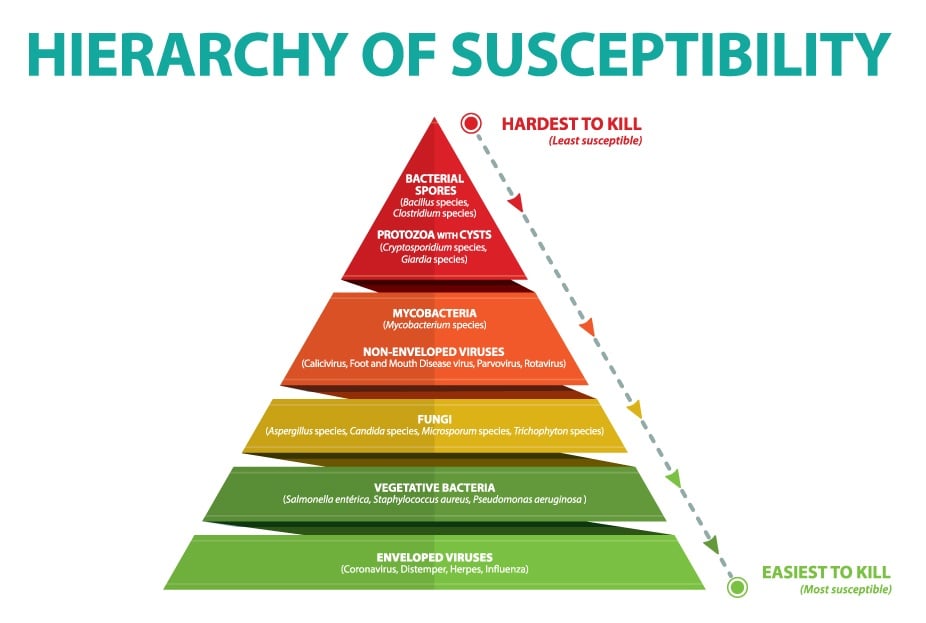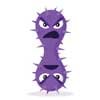
Virox Animal Health Blog
Disinfection Tales for Your Tails
Latest Stories
Featured Stories
There are many pathogens that we encounter in the animal world - some are easy to kill and

some are super tough! And the ones that we know are infectious and that may affect other animals within our facility can really cause concern for staff. We of course want to make sure those pathogens are killed before introducing an animal into that same space.
I would like to address a frequent question we get asked from veterinary clinics and shelters - and the question always starts with "are you effective against X?" To help provide context, I would like to address the concept of the order of susceptibility of microorganisms to disinfectants, also known as hierarchical scale of susceptibility (illustrated below).

It is important to understand that this is only a guide and that the efficacy of disinfectants to pathogens will vary depending on the disinfectants' active ingredient as well as how the product is formulated (e.g. two quaternary ammonium compound products with different formulations can have widely varied kill claims and contact times).
 Different manufacturers can "stack" their label with enveloped viruses and vegetative bacteria “ the two easiest to kill classes of pathogens (as you can see from the picture). They can also "stack" their label with irrelevant organisms, meaning pathogens that sound scary, but are in no way spread through contact with surfaces or medical equipment, or are just not relevant to your industry. If we choose a product simply based on the number of organisms it claims to kill without investigating further what those claims are; we could be heading down a path to disaster. As end users, we need to look at the claims and make sure that the organisms listed are relevant to us. But we also have to ensure that the classes of organisms we are concerned with on a day to day basis at our facilities have been proven effective by the product we choose or we are able to compare against other harder to kill pathogens if there is no specific claim.
Different manufacturers can "stack" their label with enveloped viruses and vegetative bacteria “ the two easiest to kill classes of pathogens (as you can see from the picture). They can also "stack" their label with irrelevant organisms, meaning pathogens that sound scary, but are in no way spread through contact with surfaces or medical equipment, or are just not relevant to your industry. If we choose a product simply based on the number of organisms it claims to kill without investigating further what those claims are; we could be heading down a path to disaster. As end users, we need to look at the claims and make sure that the organisms listed are relevant to us. But we also have to ensure that the classes of organisms we are concerned with on a day to day basis at our facilities have been proven effective by the product we choose or we are able to compare against other harder to kill pathogens if there is no specific claim.
I will use viruses as our example to speak to the hierarchy of susceptibility in a bit more detail. As you can see from the picture, non-enveloped viruses are harder to kill than fungi, enveloped viruses, etc. So for viruses that have not been specifically tested and the product does not have a specific claim against that pathogen, then we would look for efficacy against the heartier non-enveloped viruses. Typically in these situations efficacy against Poliovirus, Adenovirus, Rhinovirus or Canine Parvovirus would be considered as these viruses are known to be more resistant to disinfectants than others. For further information on virus susceptibility, check out this journal article.
At Virox Animal Health, we pride ourselves on testing our Accelerated Hydrogen Peroxide® (AHP®) products against the hard to kill pathogens and the relevant pathogens within your facility. We also ensure we provide educational material and support to answer your questions on pathogens that may not be on the label, but using this hierarchal scale to help you understand that efficacy can be expected and your facility is protected.
So I will say it again: if the disinfectant does not have a specific claim on a pathogen you are concerned with; it's great to pick up the phone and ask. But it's also important to understand that strength is not always found in the number of claims, but on the most APPLICABLE claims.
Pathogens can be scary to deal with, especially when we are looking out for our patients. But AHP® can help you attack these pathogens and no longer haunt your thoughts.
Paw you later!
Kim

Subscribe Email
Popular Stories
It's important to understand that strength is not always found in the number of claims, but on the most APPLICABLE claims.
